Everything You Need to Clicker-Train Your Cat

Can you keep your cat from shredding your sofa or attacking your legs? Is there a way to explain to her that, no, you don’t find it cute when she’s chewing your PC’s cables? We’re talking about a cat, not a dog, right?
And yet, according to Karen Pryor, the animal behaviorist who popularized clicker training, you can train even an octopus or a goldfish – or your feline best friend. We’ll go over everything you need to know about clicker training your cat, including fun tricks to teach them.
How Clicker Training Works
Clicker training works by allowing us to “tell” the animal that we liked a behavior and nudge towards its repetition. The term “animal” in clicker training refers to any living being who can learn from experience and perceive audiovisual cues. And this includes cats.
With clicker training, you can, indeed, teach your cat to stay off your kitchen counters. You can have her patiently wait while you’re cooking, or even high-five you and turn off the light when you go to sleep. By the end of this article, you’ll know how to teach your cat those tricks – and more!
So, shall we begin?
Negative Reinforcement
You return home to find your beloved furball looking apathetically at the pieces of your favorite vase. Here’s a tip: punishment won’t work. The animal won’t be able to connect the dots and perceive that the vase which broke over three hours ago is the reason for your current rage.
Your furball will only see you randomly attacking her. Cats don’t have our perception of time. Any punishment or reward for one of their actions must happen as the action occurs, or up to five seconds later.
You should prefer rewarding good behaviors instead of trying to punish bad ones, though. Cats are skittish animals and can learn to hold a grudge. For a healthy relationship, your cat should associate you with everything wonderful in life. Food. Cuddles. If you act like a predator, she’ll learn to avoid you.
Positive Reinforcement
Since negative reinforcement might lead to unwanted results, positive reinforcement is the best way to teach your cat how to behave. By convincing your cat to repeat the behaviors you like, both you and your pet win. You get peace of mind – and unbroken vases; she gets golden food nuggets and belly rubs.
Positive reinforcement can be anything your pet likes: some scratching behind the ears or playing with a string. In most cases, though, it seems the best reinforcer is food.
Unfortunately, although it doesn’t have the side effects of negative reinforcement, positive reinforcement shares the same problem: there’s no easy way to tell your cat precisely why you’re rewarding her. That’s where the clicker comes into the picture.
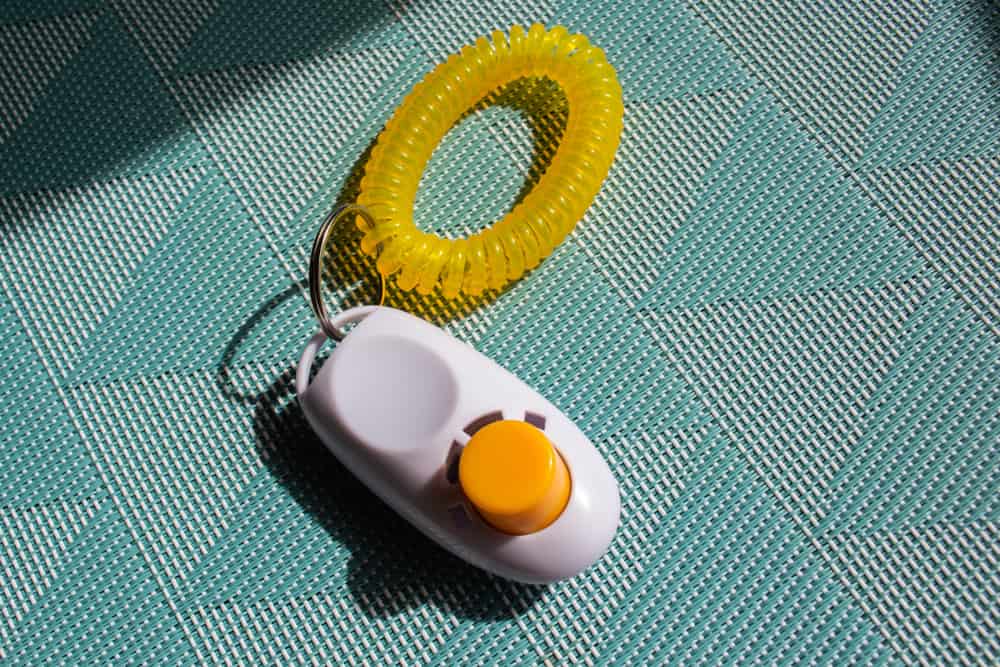
Enter the Clicker
A clicker isn’t a magical device, and you don’t even need one to train your cat. You can use any sharp sound in its place. You can also shape the behavior of deaf animals by using visual cues instead. If your pet companion is deaf, you can replace the clicker with something like a small flashlight. Anything that can instantly grab your pet’s attention can work as such a “marker.”
Theoretically, you could use your voice, but that wouldn’t be optimal. Phrases and words can be slow and inconsistent. By the time we’ve exhaled all syllables, the intended behavior is over.
Something like a clicker’s sound works better because it’s instant and distinctly recognizable. It’s also consistent since it always produces the same audible cue.
What You’ll Need
Although clicker training takes time, it doesn’t need specialized equipment to do it. Apart from the clicker itself, you probably already have everything else required: a stick, some Post-it notes, and some treats. A laser pointer is a nice extra, useful for teaching your cat more advanced tricks.
Of course, you’ll also need a cat, but you can apply what we’ll see here to train any animal in your life. At least, as long as you replace cat treats and belly rubs for something they prefer.
It Starts With the Clicker
You can find clickers for pet training at most pet shops or sites like eBay and Amazon. Although their primary audience is dog owners, you can use the same devices to train your cat.
Some cats, though, might fear a sudden loud click. As far as we know, there aren’t any softer-sounding clickers produced explicitly for cats. If your skittish furball doesn’t get used to the typical clicker’s sound, you can use something like a retractable pen instead, which produces a tamer click.

A problem with using something like a pen is that if your cat hears the same sound outside of training, she’ll expect a reward for the behavior she’s exhibiting at the moment. It’s better to find something that produces a similarly distinct sound that you rarely use in your everyday life instead. What that may be is up to you. As long as it makes a sharp sound instantly, it will do.
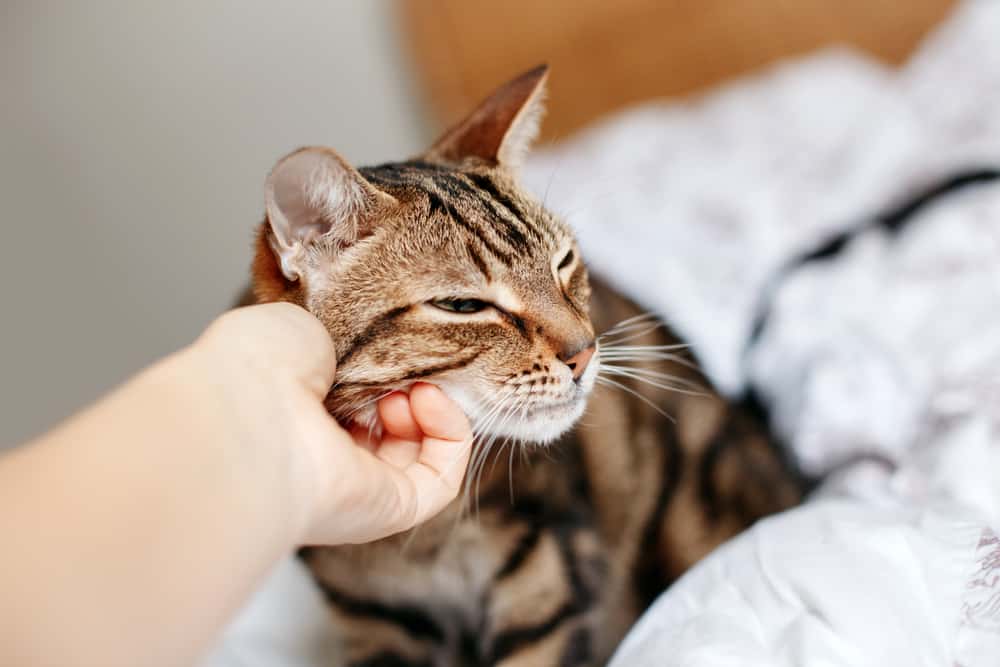
Types of Rewards
Not all cats are the same, so there’s no rule on what to use to reward any wanted behaviors. As we mentioned before, some cats like scratches and belly rubs. Others – probably the majority – are food motivated.
From Brushes to Lint Rollers
If your cat prefers contact to food, head scratches can only take you so far. When training, the rewards have to be exceptional, so try replacing a “simple” head scratch with a proper mini-massage behind the cheeks.
Here’s a strange suggestion worth trying: this humble writer’s cat hates brushes, but adores a lint roller more than anything in the world. Yes, we’re referring to “that roller with a sticky surface you might use on your clothes.” Our best guess is that it brings back memories of her mother’s tongue, cleaning her, from back when she was a kitten.
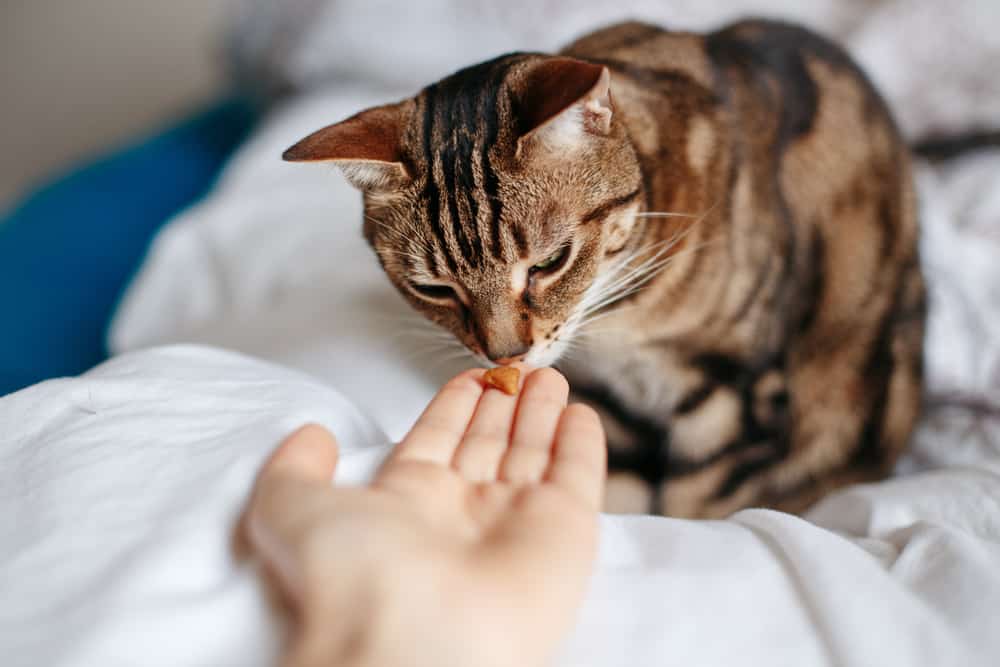
Favorite Treats
When using food as a reward, it should be extra-special to get the cat’s attention. If you use the same food your feline friend eats every day, why should she care? She might take a nap instead, until you get bored with all this clicking nonsense and refill her bowl.
Open her favorite can of premium cat food, though, or offer her a small bit of cheese, and you’ll surely get her interested. You could use cooked liver, fish, or eggs if she prefers that. And there’s always the option of something like commercially available cat treats, like Temptations.
Whether or not you like it, though, this choice is up to the cat. The more she loves the reward, the more she’ll try to appease you to make it rain a feast. Make sure the food nuggets you choose are healthy for her, though. If you use commercially available treats, read the small print: some aren’t healthy for your pet if you exceed the suggested daily dosage.
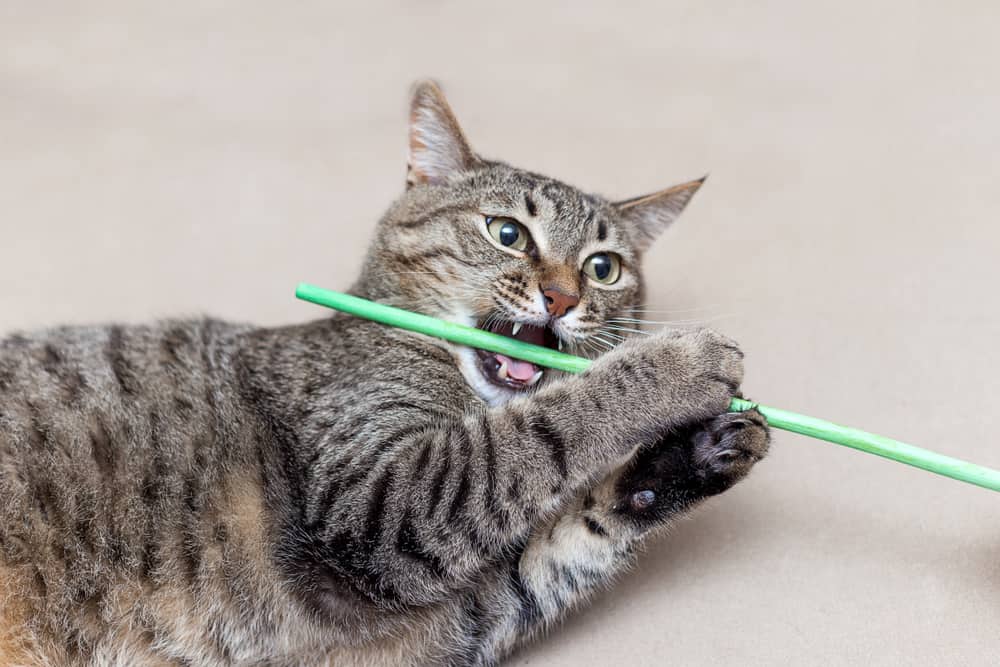
Target Stick
A target stick can take your cat’s education to the next level. You can find pet training sticks of many types and designs at pet shops, but you can also improvise. Even a retractable antenna, a chopstick, or a drinking straw will do.
It’s better if it’s somewhat sturdy, though, for when your cat decides it would be fun hanging from it.
Post-It Notes
If you want to teach your cat more advanced tricks, make sure also to pick up a pack of Post-it notes. As we’ll see, those can work as points of interest/targets when training your cat.
Laser Pointer
Most cats lose their mind when they see a laser pointer, go into hunting mode, and forget about training. For those who don’t, a laser pointer can work as an extra handy tool for teaching them even more complicated tricks.
Even if you don’t end up using it during training, though, both you and your cat can have a bit of fun with one.
The Process
The training process itself is simple and fun. We can summarize it to “you click whenever your cat displays a behavior you approve.” Unfortunately, it can also be slow and tedious, with a lot of repetition and small iterative steps. If you persist, though, your cat can be high-fiving you in less than a week!
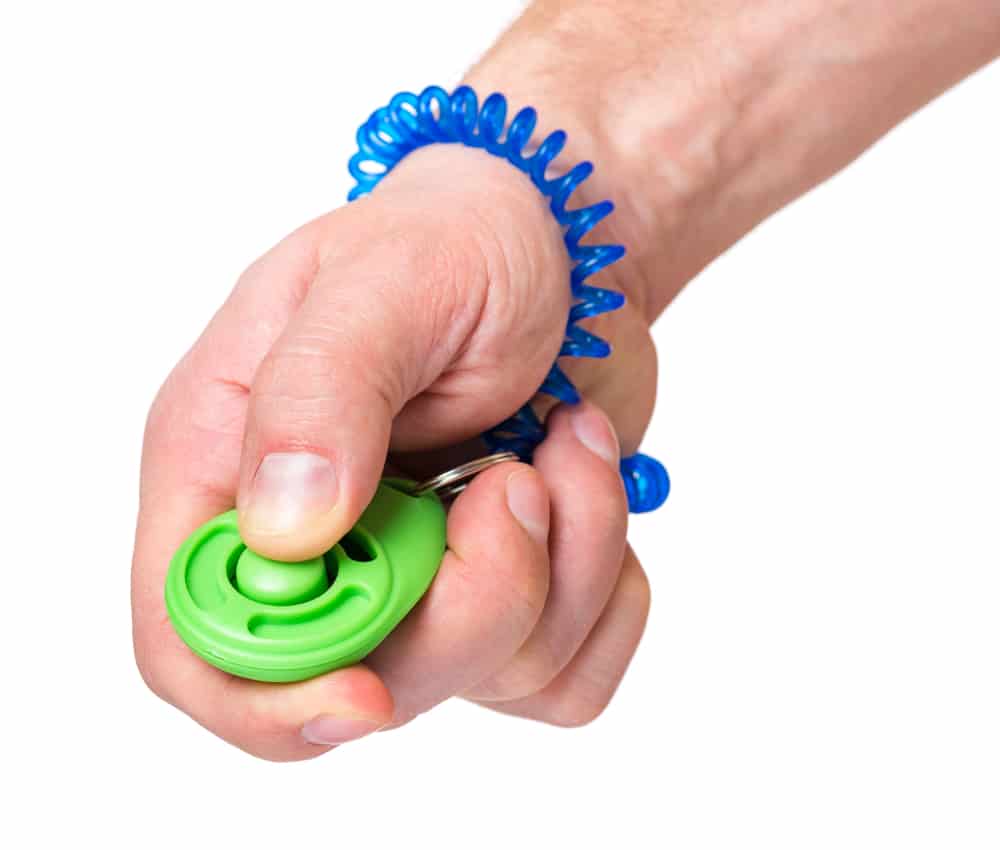
“Prime” the Clicker
A click on its own won’t mean anything for your cat. She’ll take note, though, if a delicacy comes right after. Click and treat. Through repetition, cats can learn that an action, like the click, has a reaction, an incoming, bouncing-on-the-floor food nugget. The more this happens, the more your cat will associate the click with the yummy tidbit that follows. In clicker training jargon, that’s known as “priming/charging the clicker.”
As soon as you see your cat turning her head after a click, pausing, and staring at you, waiting for the incoming goody, she’s made the association. She now knows that “click = treat,” and you can proceed to the actual training.
One Clicker, Two Paths
After “priming the clicker,” your cat will know that a click equals a treat, and you can start shaping her behavior. You can do this in two ways: by “luring” or “capturing” behaviors.

Luring
When “luring” the cat, we’re trying to somehow “trick” our furry companion to do what we want. For example, we can hold her favorite cat-candy in front of her and move it, to have her follow our hand. Then, click and allow her to an edible gift.
Note, though, that luring isn’t forcing. You should never, for example, try to push your cat in a sitting position, or grab her leg and move it around. Cats don’t like discipline. Every move should be a result of the animal’s free will.
Luring is the best way to teach your pet if you’re on a tight schedule and prefer timed daily training sessions. However, it’s not perfect: your cat might call it quits if she perceives that you’re tricking her into, for example, a high-fiving position.
Even if that doesn’t happen, cats have limited attention spans. Since you don’t want your pet to lose interest in training, keep the training sessions short. You can even teach your cat that a session ends by theatrically putting the clicker away as she’s watching. Finish on a cheerful note by offering double the number of treats and a cuddle.
Capturing
Capturing behaviors takes more time, and demands you always have your clicker and treats at hand. It involves no training sessions. As soon as your pet naturally exhibits the desired behavior, click and immediately offer a reward.
This process is slower because the pet won’t understand that there’s an ongoing training session. So, it’s probable she won’t try presenting the same behavior again. Not until it randomly happens again, and you re-reward it. Your cat might even forget that the clicks are markers for actions that we approve, and might consider them random indicators of incoming food.
The capturing approach is considered better, though, since you’ll be rewarding the animal for its natural behaviors, instead of “trying to teach it unnatural tricks” as if performing at a circus.
Wrong Clicks and Unwanted Behaviors
Since we don’t have Flash’s superhuman reflexes, you might realize you’ve clicked at the wrong time. Even then, you should still offer a digestible delight to your cat. You should never break the association between the sound of a click and the goody that follows.
As for how to deal with unwanted behaviors, you can’t click them away. You should only use the clicker to mark behaviors you like. Since punishment is also off the table, if you want a stable relationship with your pet, there’s only one solution for undesirable actions: ignoring them.
Eventually, they will go away. By reinforcing the behaviors you like, your cat will learn that some of her actions lead to a positive outcome: incoming goodies! Your cat will start presenting the rewarded behaviors more than those you ignore, because hey, treats!
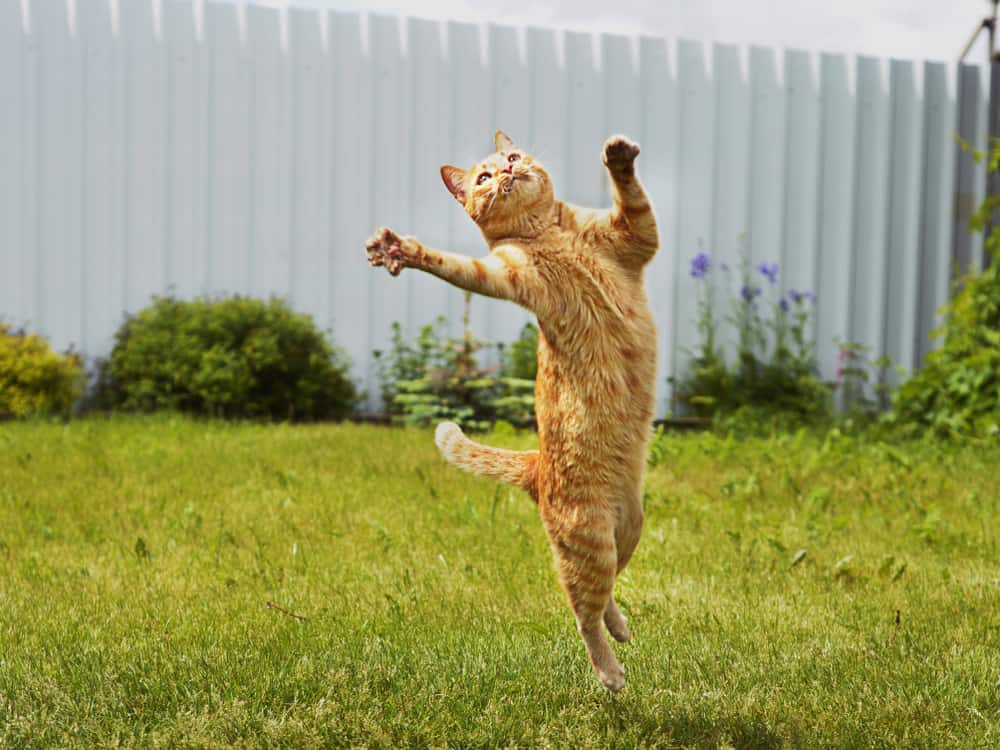
When to Click
You should always keep in mind that the very reason for using a clicker is its speed. It’s what allows you to pinpoint precisely the behavior you want to see again with a sharp, instant click. That should be a hint for when you should click.
- Click precisely when your cat exhibits a behavior you like, then immediately offer the reward, within two to five seconds.
- Is she sitting on a spot you approve instead of stretching on your table?
- Click and treat.
- Is she manicuring her nails on her scratching post instead of the sofa?
- Click and treat.
- Don’t click before or after the desired behavior. Click only while the action happens.
The more this happens, the more you will see your cat will start offering the desired behavior.
You should click before the desired outcome only when trying to teach more complex actions – and usually, that’s during “luring” sessions. This approach is more like playing Hot and Cold: you’re clicking whenever your cat gets closer to performing the intended action successfully, not only while or after pulling it off. Bit by bit, you’re nudging your pet towards the desired outcome.
Note that you should also never click more than once. A click should be a marker for a particular behavior. Consecutive clicks will confuse your feline, who won’t know which action you liked.
Adding a Cue
When your cat has learned to present a specific behavior, you can associate a cue with it. This cue can be verbal (like the command “come”) or visual (like your hand pointing towards your feet). Although the behavior should result from the cue, you can help your cat associate them the opposite way: by offering the signal right after the click, during the action.
As you repeatedly click and reward the specific behavior, “slide” the cue before the click. Soon your cat will make the connection between signal and response. After that point, she’ll start offering the behavior on cue.

How Often/Until When Should I Do It?
If your training sessions are few and far between, it will take longer for your cat to learn to display the behaviors you want. Especially with younger kittens, it’s best if you train every day. Besides helping reinforce desired behaviors, daily training will also help younger kittens think of solutions for the tasks you assign to them.
The more you reward a behavior, the more you’ll be reinforcing it. Given enough time, this behavior will become a habit for your cat. When she’s also learned to present the behavior on cue, you can slowly phase out clicking and rewarding it.
You can still reward your cat with a head scratch. Keep the delicacies as the exceptions to the rule, for when she is learning new behaviors.
As for what you can teach your cat, allow us to offer some ideas.
Teach Your Cat to…
You can teach your cat to do almost anything her physiology allows her. During your clicker training sessions, you might even realize she’s smarter than you initially thought.
For this guide, we chose some of the most important and popular things you can teach your cat since they can also work as the base for building more complex behaviors.
Come
One of the easiest behaviors to teach your cat is to come to you when you call her name.
- Stand away from your cat.
- If she is looking away, click when she turns and looks at you.
- Click when she comes to you.
- Move to a different place and repeat.
- Do it until the cat comes to you whenever you call her name.
- Remember to offer a treat after each click.
Take note that you are slowly shaping a behavior. You shouldn’t expect your cat to come running to you the first time to call her name. You should think of the act as a series of smaller steps. Reward each step until she successfully exhibits the whole behavior in one go.

Sit
When your cat comes when you call her name, she may sit next to you. That’s the perfect time to teach her precisely that command: “sit.”
Move to different spots in the room, so that she follows you, and offer a verbal or visual cue whenever she sits, followed by a click and her favorite edible nugget.
After some sessions, try presenting the cue before she sits, and reward her when she offers the behavior.
An alternative way to teach her to sit is by luring her into the sitting position.
- Move a delicacy close to her face.
- Slowly move it over her head, just out of reach.
- Don’t do it so slowly that she lashes for it, but neither too fast for she could feel threatened. You’ll know how quickly to move your hand after one or two failed attempts.
- Her natural reaction will be to keep looking at the treat between your fingers.
- Since your cat can’t move her neck like an owl, she’ll have to sit to keep looking at the delicacy when it’s directly over her head.
- At precisely that moment, click and give her the kitty-bonbon.
- Introduce a cue and repeat until she acts when you ask for it.
Wait
A cat who can sit is a cat who can wait. She just doesn’t know it yet.
- When your cat has learned how to sit on cue, tell her to “wait” before clicking and rewarding.
- The next time, delay clicking and rewarding for one or two seconds.
- Every time you issue this command, have her wait some more.
- After a while, you will be able to cook uninterrupted while your cat waits for her reward.

High-Five
A more complex but fun behavior is teaching your cat to high-five. This can be the next step after she’s learned how to sit.
- While she sits, bring your open palm in front of your cat.
- Keep your palm away from her face, at a distance where she can’t sniff it.
- If you move your palm upwards, she may try to reach it with one of her front legs.
- Click precisely when you see that behavior.
- Repeat until she touches your palm with one of her front paws. Click and treat.
- Make the move progressively harder: initially, she might touch your fingers instead of your palm or try to grab your hand.
- Don’t click unless the behavior resembles a proper high-five.
Wave Hello
As you close the door behind you, your cat jumps on your desk and looks at you. You say “hello,” and she waves back. How is it possible to teach her how to do that? If she already knows how to high-five, it’s easy to morph this action into waving her paw.
- After she has mastered high-fiving, stop issuing the audio cue, and only raise your hand.
- As she touches your hand, introduce the new signal: “hello!” Click and offer a reward.
- Do it again, but this time pull your hand a bit as she’s trying to touch it. Click before she reaches it while saying “hello,” then give her the cat delight.
- Repeat for as many times as she’s interested during a training session, progressively increasing the distance between you.
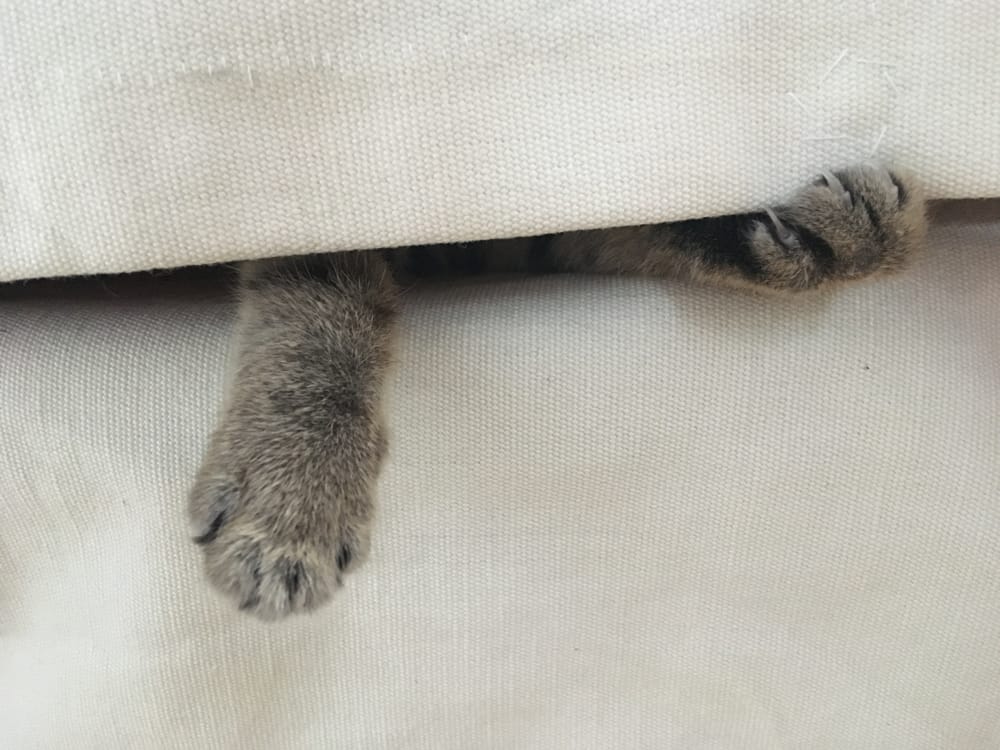
Stay
If you want to keep your cat outside a particular room in your house, even when the door is wide open, you can do it by “morphing” wait to “stay” like this:
- Enter the room as the cat follows you around, but offer the cue for waiting as you enter.
- Have her wait for you outside the room for two or three seconds.
- Click and treat.
- Issue the command for waiting again, followed by “stay.”
- Have her wait some more, up to five or six seconds.
- Click and reward her, repeating and extending the previous step.
An extension of this might help you get a good night’s sleep if your cat has the unpleasant habit of scratching on your bedroom’s door when you’re inside.
- When she’s learned to wait without entering a room, introduce your bedroom’s door.
- Have her wait outside your bedroom.
- As she’s waiting, close the door.
- Wait two seconds, open the door, click and offer a delicacy.
- Repeat by keeping the door closed for progressively more time.
As for how long you should have her wait outside, the simple answer is “as long as you’d like to sleep uninterrupted!”
Follow the Stick
A stick can help you teach your cat to follow a path or touch a spot.
- Hold your stick in front of your cat. Her instincts will drive her to sniff it.
- Precisely when her nose touches the stick, click and offer a treat.
- Repeat the process, each time moving the stick to a different position.
- Whenever she turns and tries to sniff it, click and treat.
- Move the stick further away, so she has to get up to reach it.
- As soon as she’s within sniffing distance, as you’ve probably guessed by now, click and treat.
- Repeat until your cat follows the stick wherever you move it.

Touch the Stick
When your cat follows your stick everywhere, you can try pointing it at specific points of interest you’d like her to touch.
- Touch your point of interest with the end of the stick and let your cat approach and sniff it.
- It’s almost a given that after mere seconds she’ll try to touch it with her paw.
- Click and reward her when she does.
- Move the stick and, once more, click and reward her when she touches it.
- Repeat until your cat comes and tries to grab the stick whenever you point somewhere.

Touch the Mark
Although not as easy as what we saw up to now, Post-its allow you to turn your cat into your furry home helper. We promised you can even teach her to turn off the lights. Here’s how you can do it:
- Place a Post-it note on a point of interest – for this example, your light switch.
- As with everything we saw before, wait until your cat shows interest in it. Then, click and reward.
- If you’ve taught her to follow and touch your stick, you can try pointing at the Post-it with your stick to speed up the process.
- As soon as she touches the Post-it note, click and treat.
- Do it enough times until she presents the behavior successfully every time.
- Stop rewarding her until she exerts enough force when touching the Post-it to flip the switch underneath, turning the lights on or off.
- Click and reward.
- Remove the Post-it note, cut out a strip to make it smaller, and place it again on the same spot.
- Reward her when she successfully flicks the switch.
- Repeat by making the Post-it note progressively smaller. Click and treat every time.
- Soon you won’t have any more Post-it to remove, and your cat will have learned to operate the light switch.
- Add a verbal or visual cue as we saw before and enjoy your newfound way to control your lights remotely.
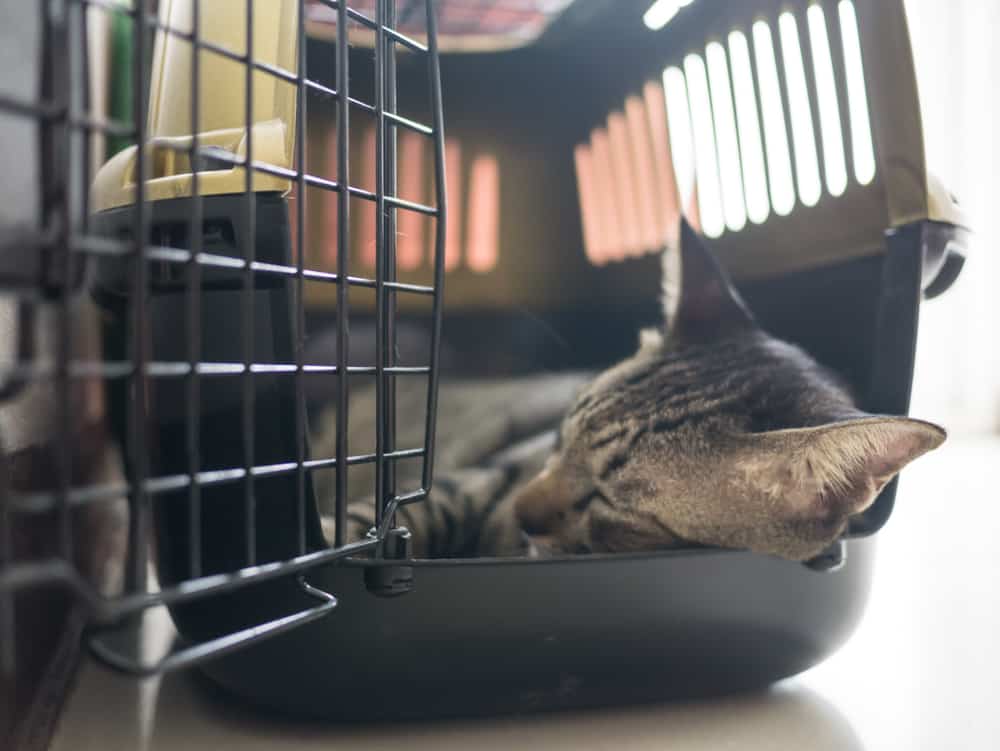
Go to Her Carrier
One of the most annoying parts of having to visit a vet is trying to convince your cat to enter her carrier. How would you like having your cat get in her carrier on her own? The trick is to associate it with happy thoughts instead of dreadful memories. And happy thoughts equals treats.
- Start by making your cat like her carrier, instead of seeing it as a temporary prison.
- Throw in one of her favorite food nuggets. As soon as she enters the carrier, click.
- Throw a second treat outside her carrier, to lure her out.
- Repeat the process by having her enter and exit her carrier.
- Throw your edible gift inside to have her enter the carrier.
- Wait two to five seconds more this time.
- Click, treat, throw delicacy outside to lure her out again.
- Rinse, repeat.
- Add a cue like “go to your carrier.”
- Repeat until she acts successfully on cue.
- Stop luring her outside the carrier.
- Only reward her when she enters her carrier and waits after you’ve told her to.
- After she’s associated the signal with the behavior, start issuing the command when she’s further from her carrier.
- Repeat until she learns to run to her carrier, enter, and wait, no matter where both of you were when you issued the command.
- As a next step, teach her not to get anxious when the door closes.
- Close the carrier’s door for two seconds while she’s inside, click, then open it and offer a treat.
- Repeat as before, each time increasing the time she has to stay in her – now-closed – carrier until you click.
Note that all of the above will probably take many sessions, but it’s worth it. You might find your cat sitting in her carrier without you having asked for it in the future. You should still reward her for that once in a while.
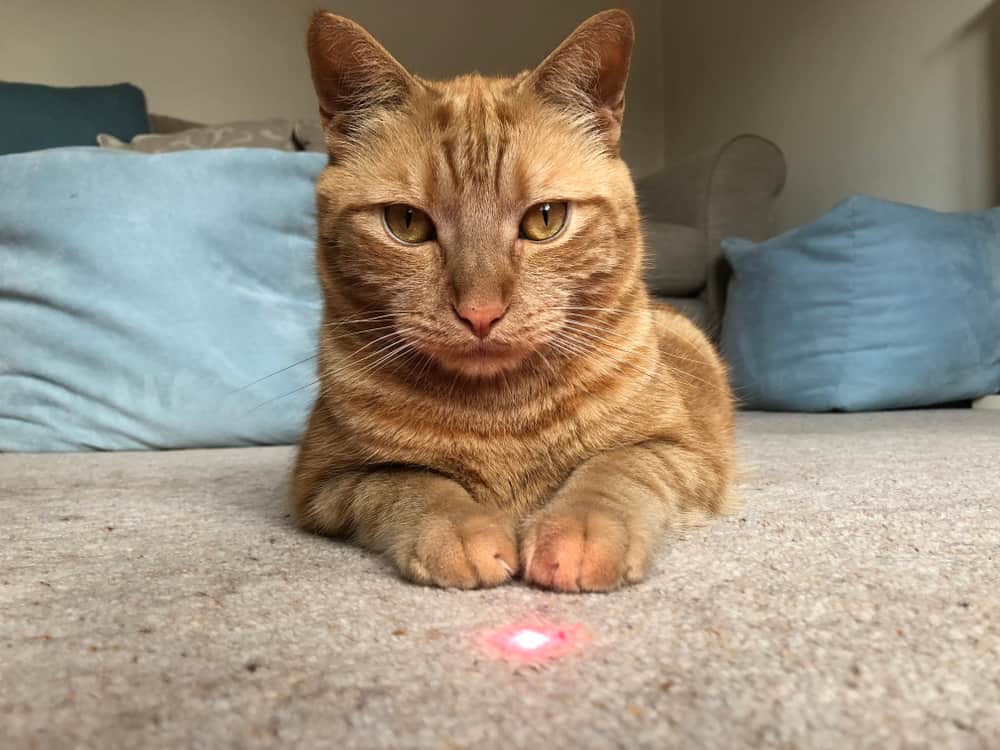
Catch the Light
If your cat doesn’t go crazy when seeing a laser pointer, you can use it as another tool in your training arsenal. A laser pointer can work as a replacement for both your stick and Post-its.
- Point your laser at a point of interest.
- Wait for your cat to touch it.
- Click as soon as she does, turn off the laser and offer her a reward.
- Repeat until your cat touches that spot with no red dots involved.
- Continue rewarding your cat whenever she touches the same place without you pointing at it with your laser, exhibiting the behavior on her own.
You can instead have the dot – and the cat running after it – follow complex paths.
- Mentally split into segments a path you’d like your cat to follow.
- As your cat traverses each section of the path, click and reward it.
- Use your laser pointer as a guiding light through the path.
- Reward her for each segment individually.
- Keep rewarding her for successfully going through longer and longer sections, until she can go through the whole route in one go.
Better Living Through Clicking
Many believe it’s better if you start clicker training a kitten when it’s young – even two months old. This way, it’s easier to shape behaviors that will turn into habits. That doesn’t mean you can’t clicker-train older cats. Even five-year-old strays have been clicker-trained to respect their new homes.
One of the most important benefits of clicker training is how it can radically improve your relationship with your cat. By spending time with your companion animal, using this unexpected clicky way of bidirectional communication, you’ll strengthen the bond between you.
From the animal’s perspective, you’ll be equals. Or, if we’re to admit the truth, that she’s the one pulling the strings. She’ll be the one “making you give her treats” through her actions. She won’t see you as a dominant predator trying to force her to perform tricks, but as her friendly giant who makes yummy food-bits drop from the sky.
Thanks to clicker training, your cat can behave like a well-trained dog, and both her and your sofa will love you.




